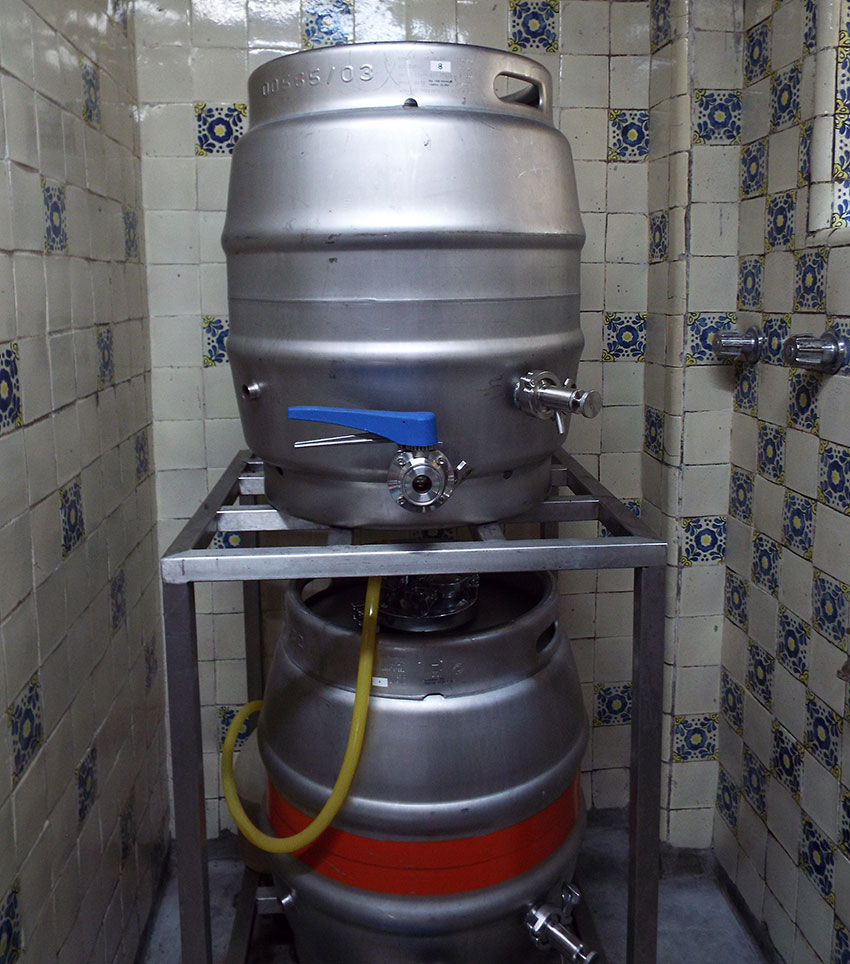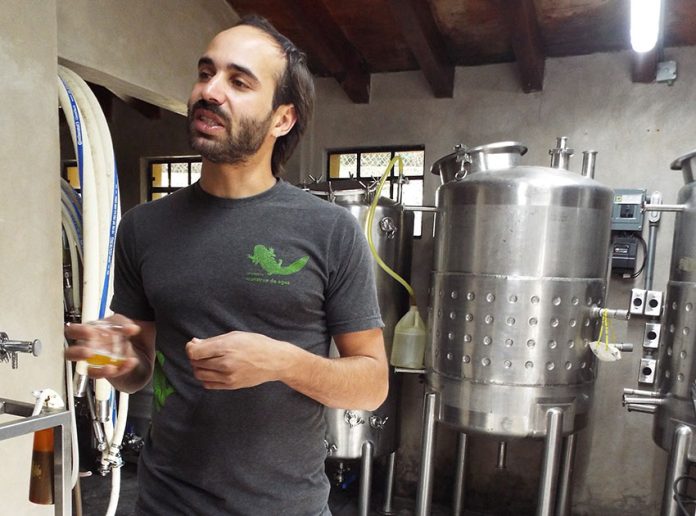The smell of sweetgrass floats up to my nose as I sip Monstruo de Agua’s Sugoi. Its gingery tang turns into a lavender-honey sweetness; there’s the slight bitterness of the lemon tea; the light aguamiel sweet, and something else… I can’t quite put my finger on it. A hint of forest?
Thirty-five miles south of Mexico City, tucked up against the Ajusco national park, the dust and smog of the city is replaced by the smell of ancient oak, oyamels and pine trees. This is this beer’s source.
Here in the town of Topilejo, 50 years ago, when there was little more than a handful of families and never-ending forest, Virgilio Larralde’s father built a little yellow house, never imagining that one day it would be the home of a curious microbrewery.
Now the remnants of his daughter’s tiled shower house a 100-liter production tank, the rooftop has been converted into a rainwater catchment system, and Monstruo de Agua’s logo – the endangered Mexico City axolotl — covers every inch of the house, from the giant hanging sign in the brewery to the beer glasses on the shelves.
Virgilio, who spent his childhood in the house, is one of the members of the Chinampa collective, a group of friends that came together seven years ago with the hope of creating a sustainable project in Mexico City. The 12 members of the collective are now spread around the world, including founder Carlos González Romano, an MBA student from ESMT Berlin who wants to bring their unique cervezas to the mecca of beer – Germany.

He’s the one that reached out to me to try the beer and connected me to head brewmaster Matías Vera Cruz, who makes the trip out to Tepilijo twice a week to check on their creations.
Matías shows me around the property, pointing out the plants they’ve used in recent experiments — kumquat, pomegranate, lemon balm, strawberries, six types of sage, an acidic lettuce he can’t remember the name of, dill, fennel, capulín (a Mexican berry somewhere between a cherry and blueberry), dandelions, bolted cilantro and plum flowers. He rubs some wild marigold between his finger and offers me a sniff. When he gets to the fig tree his face darkens.
“I hope it will last through the winter.”
He samples as he walks through the edible forest that he and his fellow brew makers, along with Virgilio’s father, have been creating on the 4,800 square meters of property behind the house. You can almost see him dreaming up the next Monstruo de Agua concoction, maybe one of their new probiotic sodas.
While he’s a fan of beer, Matías’ scientific spirit brought him to beer making and to the project. In fact, at first the members of the Chinampa collective wanted to have a big piece of property on a beach somewhere and work with hydroponic and aquaponic agriculture. At that point Matías and Carlos had already been tinkering with beer as a side hobby.
“I didn’t start making beer from this really purist perspective,” Matías says, “with the idea that beer had to be a certain way. The fact that it was beer was to me secondary to what I was doing.”

His real curiosity was in creating a new, unique kind of carbonated beverage, so the limits of what was appropriate to include in the recipes didn’t apply. He’s used cedar berries to give their beer the acidity usually added by hops, he’s used the natural fungi on their raspberry plants in place of ordinary yeasts. He doesn’t much bother with rules.
Still, Blanca de Maguey, their most popular and award-winning beer, emerged anyway, along with the Sugoi with lemon tea and ginger, a stout made with fig leaves and sugar cane. Each season they make new seasonal beer and each year create collaborations with other breweries. That’s in addition to the dozens of small-batch experimental beers that never even left the lab. The unusual ingredients they are dabbling in are what gave birth to the edible forest.
“The idea of an edible forest began with my misconception that within the market I would always be able to find the product or producer I wanted. The Central de Abastos [Mexico’s largest bulk market] isn’t a farmers’ market. I mean it’s not a Walmart either but… you get what I’m saying,” Matías says.
So he gave up trying to source everything from the outside and starting growing many of the ingredients he wanted to use. What wasn’t available they purchased, but with an eye on buying local and supporting not only organic agriculture, but non-monocrop and GMO-free agriculture as well. The scarcity of hops in Mexico (there are ongoing projects to grow hops in Baja California but generally they don’t grow well here) led to some experiments with hop-free beers.
“The dominance of hops has more to do with politics than it does with it being the best way to make beer,” he tells me as we sip one of my favorites of the day — a limited edition honey wheat beer so ephemeral that it never even got an official name.
While you might think that sustainability is Matías’ top priority (and you wouldn’t be wrong that that’s important to him), the impetus behind using all these local products and endemic ingredients goes beyond simply supporting local farmers. The way he explains it, Monstruo de Agua is looking to craft identity – Mexican identity – through their beverages.
“Terruño, that’s my word of the year. One part is literally the earth and the ingredients, the qualities of the land being cultivated that makes every country distinct. But in reality when you talk about terruño there is also a cultural element to it. Mexico is a mega-diverse place, ecologically speaking, but also culturally speaking. That’s not a surprise, but not all countries that are ecologically mega-diverse are also so diverse culturally.
“In Mexico in general this is an interaction of bio-cultural identities, and it comes from the diversity in the land. I think that our beers don’t represent that diversity and that’s why our craft beer market remains small. But it’s also just emerging,” he concedes.
Everything from the 80,000 liters of rainwater captured and filtered on their roof to the plants in the garden to the barley they malt with a partner in Mexico City to their very logo of the axoltl, a species only found in Mexico City’s canal system, incorporates the notion of terruño – a homeland, a native ecosystem.
While there is lots of incredible craft beer coming out of Mexico right now, Monstruo de Agua is a curious outlier, not always playing by the international rules of beer making. Instead they are creating beverages that reflect their passion for place and a sense of home. As they start exporting to the U.S. this year, watch out for even more surprises.
The writer lives in Mexico City and is a frequent contributor to Mexico News Daily.
